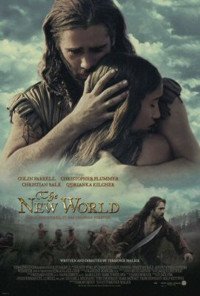Viewing: The New World
 I am a lover of history, especially American history. When a new, historically based movie hits the market, I get all excited. A few evenings ago, Sally and I viewed one that we both found to be quite exceptional—The New World.
I am a lover of history, especially American history. When a new, historically based movie hits the market, I get all excited. A few evenings ago, Sally and I viewed one that we both found to be quite exceptional—The New World.In school, we learned about the Pilgrims and how they came to America in 1620. At Thanksgiving time, we made construction paper cut-outs of turkeys and pilgrim hats and Indian headresses and talked about the first Thanksgiving. But I do not recall learning much about the first, permanent, English settlement in America—Jamestown 1607.
Next year, Americans will celebrate the 400th anniversary of the landing of the Susan Constant, the Godspeed, and the Discovery along the banks of the James River. That spring, thirteen years before the Pilgrims landed at Plymouth Rock, one hundred and five men and boys disembarked those three ships and set up a new home they called Jamestown in honor of England's King James (the same one who commissioned the English translation of the Bible which was published in 1611). From Jamestown, they hoped to launch a quest for gold and the elusive Northwest Passage to the far east. They found neither.
But they did encounter the Powhatan Indians, a local Algonquian tribe living along the banks of the James River near the fall line (now Richmond, Virginia). The English and the Powhatan had a very tenuous relationship, at times friendly, and other times at war.
Much of what is known of those first days of American history is drawn from the diary of Captain John Smith, the adventurous English explorer who led the rowdy and undisciplined Jamestown settlers, traded with and fought the Powhatan, and explored much of the Chesapeake Bay region. Smith was known as boastful and arrogant, and so historians have questioned the degree to which his accounts are embellished. However, several independently-sourced documents have tended to verify many of his brash claims.
The New World tells the story of Jamestown, Captain John Smith, the Powhatan, their chief, their chief's young daughter Pocahontas who took an immediate liking to Captain Smith, and tobacco farmer John Rolfe. Many are familiar with this classic, American story. How much of it is true, and how much is legend, we will likely never know.
The film paints the encounter and clash of these two civilizations in a wonderfully artistic way, with minimal dialogue, and abundant imagery. The New World focuses much of its attention on the young Pocahontas, played by newcomer Q'Orianka Kilcher, a gifted young star whose portrayal of the Indian princess is majestic.
 The love between Pocahontas and John Smith is seen not in the typical Hollywood fashion—sex, but through shy glances, tender touchings of the hair and the face, and finally in the sparse, loving embrace. Rated PG-13 for minimal violence, the film portrays love the way the classic films once did—no sex, no nudity, no crass talk—simply with tenderness and sensitivity.
The love between Pocahontas and John Smith is seen not in the typical Hollywood fashion—sex, but through shy glances, tender touchings of the hair and the face, and finally in the sparse, loving embrace. Rated PG-13 for minimal violence, the film portrays love the way the classic films once did—no sex, no nudity, no crass talk—simply with tenderness and sensitivity.The New World spans nine years and ends in England, where Pocahontas (now with the Christian name Rebecca and married to tobacco planter John Rolfe) is invited to the court of King James. As Pocahontas and her Indian bodyguard (Wes Studi) explore the streets of London, we see just how gifted an actress the young Kilcher is, as her eyes explore sights she could never have imagined from her home in the forest along the James.
If you don't know how this story ends I won't tell you here. But it is an uplifting story of the power of love.
Rent this movie and watch it with your family.

1 Comments:
Dave, I'm sorry you guys didn't like it. We loved it (as should be obvious from my review).
The film was somewhat choppy. And there were unexpected "jumps" from one time period into another with minimal transition.
We particularly liked the way that the Pocahontas character was portrayed. And the way she remained faithful to her husband despite her feelings for John Smith. That is so "un-Hollywoodish."
Post a Comment
<< Home